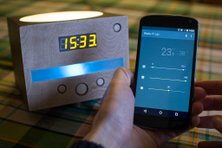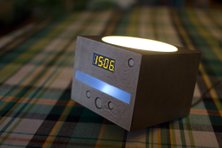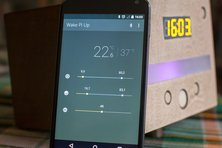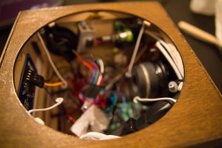Wake Pi Up is a luminous alarm clock that
uses a Raspberry Pi. It is in a wooden box,
and is controlled by an Android application.
Thanks to Thibaut Dirlik for the base idea.
See the Features
uses a Raspberry Pi. It is in a wooden box,
and is controlled by an Android application.
Thanks to Thibaut Dirlik for the base idea.
See the Features

The time is automatically synced with the phone’s time at each bluetooth connection.
Before an alarm rings, the light slowly increases, then music is played (from usb key).
The right bottom dot is enabled on the digital display when an alarm is scheduled for next morning.
Before an alarm rings, the light slowly increases, then music is played (from usb key).
The right bottom dot is enabled on the digital display when an alarm is scheduled for next morning.
There are four front buttons for the most important actions:
- snooze (or start playing music if no alarm, or disable alarm / stop music in case of long press)
- increase/decrease light/volume, or previous/next song (depending on current mode)
- button allowing to change the current mode
The rest of the actions is availbable through the smartphone application.
A 'zero-light' mode allows to avoid any light pollution during the sleep.
The alarm clock is almost entirely dismoutable, so replacing pieces is easy, as well as doing improvements.
See the smartphone app features
A 'zero-light' mode allows to avoid any light pollution during the sleep.
The alarm clock is almost entirely dismoutable, so replacing pieces is easy, as well as doing improvements.
See the smartphone app features

The android application allows to fully interact with the alarm clock and control it, using bluetooth.
Main components
Here are its main features:
- display of external/internal temperature (Raspberry Pi’s SOC temperature in fact)
- seekbars to adjust minimum/maximum brightness levels of LEDs
(maximum level is for light variations according to music) - seekbar to adjust brightness of digital display
- define alarms, be able to enable/disable them
- control music played by the alarm clock: play, pause, stop, previous/next
- search and play music (regexp allowed)
- web audio streaming support (webradios...)
- tag musics for sleep, and be able to play these tagged musics.
- set led modes: beat according to bass, mediums, trebles, or hybrid mode for the RGB led (trebles + color change on bass)
Main components

Main components:
- Raspberry Pi (B+)
- 4-in-1 7segment display (i2c) (http://www.adafruit.com/products/879)
- 3W LED (warm white) + heat sink
- LED driver (CAT4101) + a piece of aluminium as heat sink
- 5mm RGB LED
- bluetooth USB dongle
- temperature sensor (i2c) (TMP102)
- 5V USB speaker (I took one speaker from a stereo speaker set + the audio amplifier)
- 4 push buttons
- male micro USB connecter
- 5V / 4A power supply
- USB audio card (small and cheap) (indeed I couldn’t use the hardware PWM for LEDs and use the Raspberry pi’s audio output that also uses the hardware PWM)
- audio jack splitter (there is an audio output behind the alarm clock)
- USB key to store music files
- breadboard, wires, resistors, capacitors, heat-shrink tubing
For the casing:
- wood (2,0mm birch plywood)
- plexiglass (2,0mm, frosted)
- varnish (chestnut + colourless)
- magnets (front panel is easily removable)
- wood rods, glue, screws ...

Languages:
Libs / external soft:
- Python
- C and Cython (use of the GPU of the Raspberry Pi for FFT calculation for music light beats)
- Android application in Java
Libs / external soft:
- wiringPi (http://wiringpi.com/ https://github.com/Gadgetoid/WiringPi2-Python)
- RPIO (https://github.com/metachris/RPIO/)
- PyBluez (https://pypi.python.org/pypi/PyBluez)
- GPU FFT (C lib allowing to compute FFT using the GPU of the raspberry pi) (http://www.raspberrypi.org/accelerating-fourier-transforms-using-the-gpu/ http://www.aholme.co.uk/GPU_FFT/Main.htm)
- decoder (module for decoding compressed audio files) (https://pypi.python.org/pypi/decoder.py)
- avconv